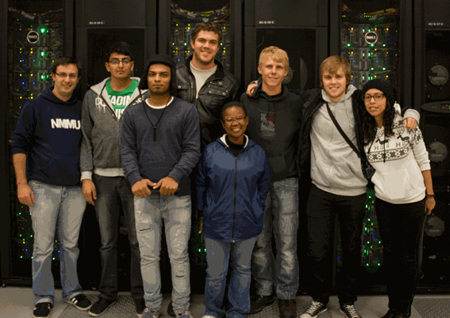24/01/2014
"In December last year, four of us from NMMU (myself, Douglas Bentley, Liam Carver, and Matthew Sainsbury) took part in the Student Cluster Competition held by the CSIR in Cape Town. Our team came in second place, only narrowly beaten by the team from UWC. A team of six was chosen to take part at the International Supercomputing Conference that will be held in Leipzig, Germany, later this year. The team is made up of the four members from UWC, along with two others chosen from other teams. Two reserves were also chosen, of which one was me. This means that if someone cannot make it to Germany for any reason, then I will step in to take their place.
Between the 25th of January and 3rd of February I visited Dell’s headquarters in Austin, Texas, as part of preparation for the ISC competition. We spoke to experts from Dell in all sorts of fields ranging from GPU (Graphical Processing Unit) optimization to NFS (Network File System) configuration. We attended various talks throughout the week, and had lots of opportunities to ask them questions relevant to the competition. Dell will be sponsoring the equipment that the team will use.
The competition in Germany will see the team run a multitude of benchmarks that we will need to ensure our cluster can finish as quickly as possible. The only constraint that we have on the cluster is that it cannot exceed a power draw of 3kW, which is not a lot considering that current gaming PCs often have 1kW power supplies.
During our visit, we also got to visit the University of Austin’s visualisation lab, and TACC (the Texas Advanced Computing Centre). The visualisation lab is used to take various computer rendered objects, such as a simulation of the earthquake in Japan, and view them on a massive wall of connected monitors (80 in total). At TACC we got to see Stampede, which is currently the 7th fastest supercomputer in the world. To give a few specs, it has 6400 computers linked via roughly 120km of high speed inifiniband network cables. Each computer has a high performance Intel Xeon processors, as well as an Intel Xeon Phi coprocessor, which gives the entire cluster a total theoretical peak performance of just under 10 petaflops. That’s about 10 quadrillion mathematical operations per second! The cluster also has 270TB of RAM, and about 14PB (a petabyte is 1000 terabytes).
The entire trip was an amazing once in a lifetime experience, and I learnt an incredible amount while I was there that I will hopefully be able to use in my studies and work after I am done."

Representing universities across South Africa, the 2014 ISC Student Cluster Team visits Dell Headquarters in Texas, USA. Kevin Beyers, from NMMU, is on the far left.